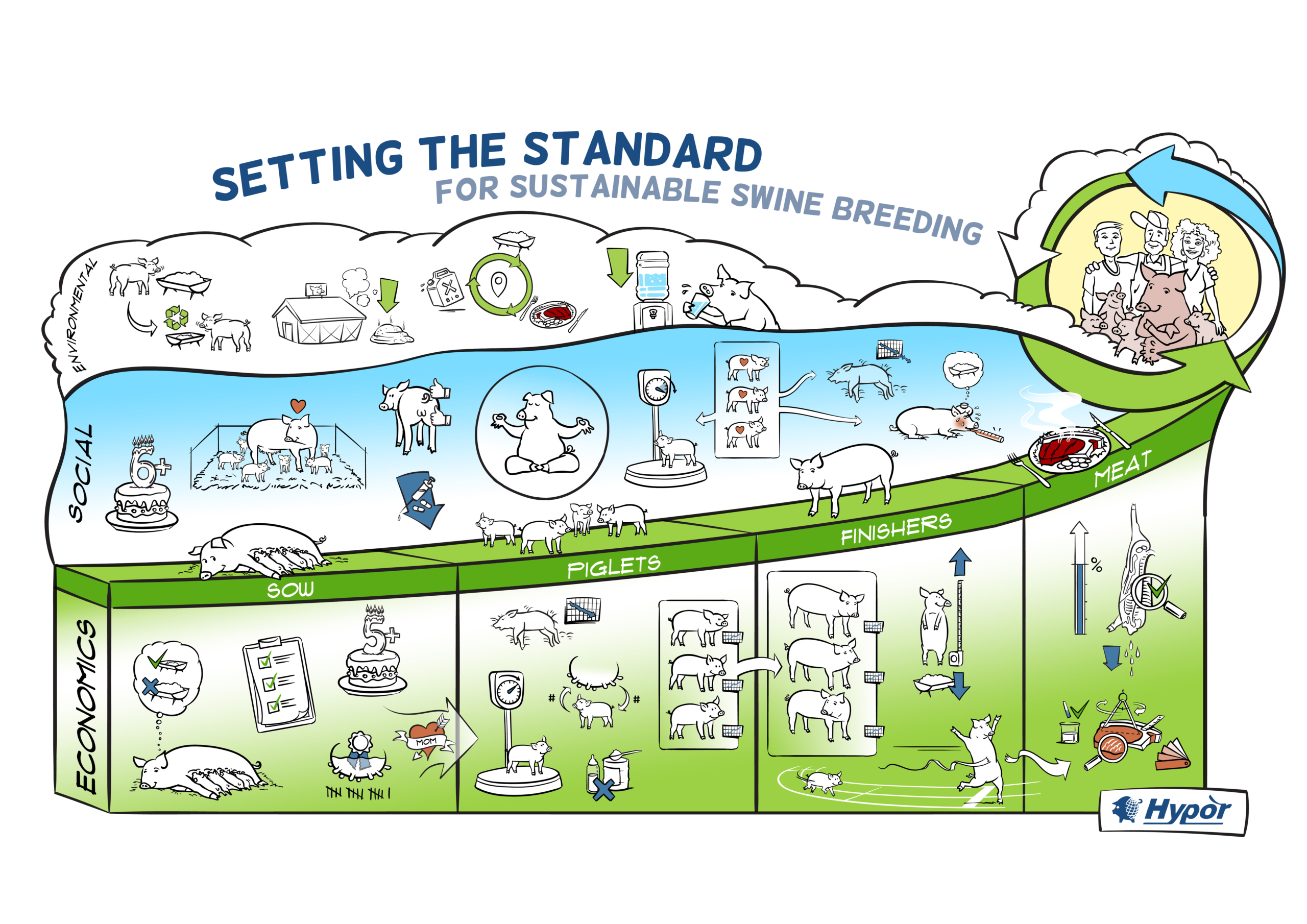Setting the Standard in Sustainable Swine Breeding with the Right Products
This blog post is sponsored by Hypor.
Balanced breeding focuses on balancing the progress of many traits to generate profitability for the total pork supply system. These traits can be classified into (re)production and efficiency traits, and with increasing attention more recently, into animal health and welfare traits. After decades of focusing on balanced breeding, we have reached a new era, where we transition from balanced breeding to sustainable breeding.
Sustainable swine breeding encompasses the economic, social, and environmental aspects of sustainability. As a global leader, Hypor, the swine brand of Hendrix Genetics, wants to set the standards on economic, social, and environmental sustainability. This focus will pave the way towards a more sustainable pork industry and this evolution is more important than ever.
Economics Are the Foundation
For a viable pork sector, economics are the foundation of every production phase. The genetic progress we aim to deliver with our Hypor sows, piglets, finishers, and pork, creates economic returns for the entire pork chain. Our breeding philosophy starts with a calm, (feed) efficient sow, that is easy to manage and with the capacity to wean her own high-quality piglets, all in a longer reproductive life. This is followed by ensuring more full value finishers reach the processing plant in the most efficient way and provide the right carcass characteristics for the market.
Selection for Social Sustainability
By selection for self-reliant animals that thrive in all environments, we simultaneously set new standards on social sustainability. Animals that can take care of themselves, without intervention or support, are a critical component of social agricultural development. This includes sows that perform well in any housing system, piglets with heavy and uniform birth weights for better survival, and finishing pigs that get along well with their pen mates and thrive to market.
In addition to focusing on the quality and self-reliance of our animals, we are researching new genetic technologies. This includes ways to eliminate animal treatments like castration, as well as vision and sensor technologies to remove the need for tail-docking. In the end, delicious and nutritious pork is our ultimate promise to the consumer as sustainable breeding and husbandry practices gain further social acceptance.
Reducing Our Environmental Footprint
Hendrix Genetics raises the bar on environmental sustainability. To reduce the industry’s footprint, introducing sustainable conversion ratio (SCR) is key. There is more to feed conversion than simply calculating feed volume against meat volume. In addition to generating genetic progress in feed conversion, we need to research the effects of emission-reducing diets and alternative ingredients; both are needed to resolve the food-feed-fuel conflict.
WHAT STANDARDS HAVE WE SET FOR SUSTAINABLE SWINE BREEDING?
By committing to setting the standard in sustainable swine breeding, we started by setting five standards. These standards will impact all three pathways to sustainability and can be grouped within enhancing efficiency, improving health and productivity, and preventing waste.
Enhancing Efficiency
Genetic progress is primarily focused on enhancing efficiency to create economic returns for the pork chain. The efficiency of how sows, piglets and finishers produce pork lies at the foundation of our Hypor breeding program. Next to feed efficiency for all products, labor efficiency is also important. Farm labor is increasingly scarce, and therefore calm behavior and easy management for all life stages are important. These characteristics result in lower requirements for human-animal interactions and results in better animal welfare.
An example of sow efficiency is ensuring she is equipped with the right qualities, such as having enough teats. With sufficient functional teats, the sows are able to provide their offspring with quality colostrum and milk.
Our sustainable standard for a number of functional teats: 4 x 4 = 16
The number of teats and the position are important. We are working towards 16 teats in total: 4 sets above the navel and 4 sets below the navel. With the overall goal that the number of functional teats is the same as the number of total born piglets to prevent the need for nurse sows.
Improving Health and Productivity
Productivity is normally defined as the ratio between the output of production and the input of production factors. However, the quality of the output is also critical, and quality is important right from the start. Therefore, we put selection pressure on piglet birth weight and uniformity of birth weight in all of our product lines. Heavy, uniform piglets are more likely to survive and become full value finishers in fewer days. This is not only important from an economic perspective, but also in terms of social acceptance and more efficient resource use in all life stages.
Our standard for sustainable piglet birth weight: 1.5 kg/3.3 lbs.
Piglet birth weight is proven to influence lifetime performance, with heavier birth weight piglets being more likely to survive and reach market in fewer days. We strive to have an average piglet birth weight of 1.5 kg (3.3 lbs) and no piglets <1 kg (2.2 lbs) at birth.
In line with our approach to piglet quality, this is also balanced with prolificacy of the sow. We have decided to put a limit to the number of piglets born per litter to match the number of functional teats and to focus on piglet survival and quality. This will help to minimize the number of stillborn piglets and improve pre-weaning survivability.
Our Standard for Sustainable Litter Characteristics: 16-15-14
16 piglets total born, 15 piglets born alive, 14 piglets weaned. For every increase in total born, this should be accompanied by the same increase (or more) in born alive and weaned. Focusing on these sustainable litter characteristics improves piglet quality, manages the demand placed on the sow, and reduces the need for nurse sows.
Preventing Waste
The Hypor breeding program is geared towards delivering self-reliant animals. This includes raising productive animals that decrease the environmental footprint through the reduction of ‘waste’. Animals that overcome disease challenges have greater survivability and improve the overall efficiency. More efficient animals have a positive impact on land use because they utilize fewer resources. In the Hypor breeding program, to reduce the pork production footprint and prevent waste we work on: 1) feed efficiency, or in the future, towards sustainable conversion 2) survival; every pig that makes it to market is an efficient use of feed and feed ingredients.
Our Standard for Full-Value Finishers: 95%
Any pig that reaches the market and/or slaughterhouse requirements at the specified target weight (depending on the region). This means 95% of pigs placed in the nursery must reach the market, and we steer towards 2% nursery mortality and 3% finishing mortality.
Finally, after all the energy and resources invested in raising pigs, we should consider the end product. The economic return on a carcass is dependent on the region. The grids will vary around the world, but our sire lines are well suited for many markets, with carcass characteristics that fit grids well.
Our Standard for Carcasses Hitting the Grid: 98%
Of the full value finishers that reach the market, we strive for 98% of these pigs to hit the grid. It is dependent on the market whether these grids use a live or carcass weight, muscle or fat depth, lean yield, or primal yield targets.
THE HYPOR PRODUCT PORTFOLIO: SUPPORTING SUSTAINABLE SWINE BREEDING
Sustainable swine breeding is an overarching focus in our pig breeding program, but there also key components that relate specifically to the different products in our portfolio. Our sow, the Hypor Libra, is an efficient sow who farrows high quality piglets, who in turn before full value finishers. Our sire lines are suited for many markets around the world, but are built on the foundation of quality piglets, quality finishers (for example, growth, feed conversion, or added value), and quality meat for the target market. The characteristics of our product portfolio, born out of balanced breeding, ensure that economic, social, and environmental sustainability can be achieved.
Maternal Efficiency
Starting with the sow, our Hypor Libra provides great economic value, but her traits can also be appreciated for their contribution to social and environmental sustainability. The Hypor Libra is bred to be a productive and efficient mother. This can be classified through superior stayability, which relates to her ability to wean at least three litters and is also a function foot and leg structure. Hendrix Genetics is the only global genetic company to fully group house their dam line nucleus females during gestation, which inherently selects animals with good feet and legs.
Another aspect of stayability is sow mortality, which is becoming an increasing concern in the industry. Our customers see at least a 2% advantage on sow survival compared to the industry average. The Hypor Libra can also easily wean her own piglets by having enough functional teats. Not only does this benefit the piglets, but there is also better farrowing room efficiency when nurse sows are not needed.
Quality Piglets Right From the Start
The importance of piglet quality is considered in all Hypor products because we recognize the influence on lifetime performance. It is well documented that piglets with a heavier birth weight have a higher chance of survival and becoming a full-value finisher, all in fewer days. By measuring individual piglet birth weights, we can select animals (both dam and sire line) that consistently produce uniform litters of piglets with heavy birth weights. The combination of our Hypor Libra with our Hypor Magnus or Hypor Maxter produces piglets with an average birth weight of 1.5 kg/3.3 lbs. with 94% weighing more than 1 kg/2.2 lbs. These strong, high quality piglets will thrive, survive, and need less human intervention, which is ideal for animal welfare, economic returns, consumer acceptance of pork production, and overall resource use.
Valuable Finishers Offer Big Advantages
We recognize that the sow and the boar contribute to the final market hog, so balance between traits is crucial in all of our products. The result is a product portfolio with a sow that is efficient in producing and weaning piglets that grow uniformly, fast, and in a feed-efficient way. These pigs are also more likely to become full value finishers, which positively impacts all three layers of sustainability. The producers have more market pigs to sell, the consumer is confident that they are buying pork from healthy pigs, and the resource use is minimized as much as possible.
The Hypor Magnus is our commercial Duroc, who will bring fast and efficient growth. The Hypor Maxter is our Piétrain, who is leading for growth and uniformity. The Hypor Kanto is our premium meat quality Duroc, who will also bring exceptional growth in the barn. Regardless of the market, Hypor has a sire line to suit your production needs.
More Quality Meat for Many Markets
The final stage of production is the consumer product, which varies around the world. These requirements are readily met with the different sire lines in the Hypor portfolio, with carcass characteristics that easily fit many grids.
For markets looking for high carcass yield, deeper loins, less backfat, and quality meat, the Hypor Magnus, our commercial Duroc, is well suited. If the target market is more of a lean market, with exceptional carcass uniformity, the Hypor Maxter, our purebred Piétrain, is the right choice. For markets that are truly seeking premium eating quality, the Hypor Kanto is our other purebred Duroc sire line selected to fit in these markets.
Transitioning from balanced breeding to sustainable swine breeding is the next step. Consideration of the three sustainability pathways is needed to breed swine solutions that are economically viable, socially accepted, and environmentally sound. As a global leader in swine breeding, Hypor, the swine brand of Hendrix Genetics, is setting the standard in sustainable swine breeding with the right product portfolio.







